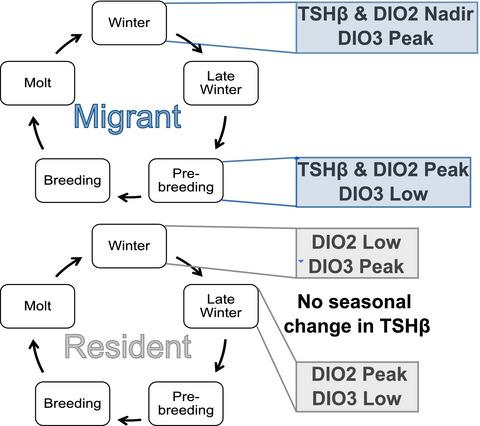当前位置:
X-MOL 学术
›
J. Neuroendocrinol.
›
论文详情
Our official English website, www.x-mol.net, welcomes your
feedback! (Note: you will need to create a separate account there.)
Seasonal differences in hypothalamic thyroid-stimulating hormone β, gonadotropin-releasing hormone-I and deiodinase expression between migrant and resident subspecies of white-crowned sparrow (Zonotrichia leucophrys)
Journal of Neuroendocrinology ( IF 3.3 ) Pub Date : 2021-08-16 , DOI: 10.1111/jne.13032 Jonathan H Pérez 1, 2, 3 , Jesse S Krause 2, 4 , Valerie R Bishop 3 , Angus M A Reid 3 , Michael Sia 3 , John C Wingfield 2 , Simone L Meddle 3
Journal of Neuroendocrinology ( IF 3.3 ) Pub Date : 2021-08-16 , DOI: 10.1111/jne.13032 Jonathan H Pérez 1, 2, 3 , Jesse S Krause 2, 4 , Valerie R Bishop 3 , Angus M A Reid 3 , Michael Sia 3 , John C Wingfield 2 , Simone L Meddle 3
Affiliation

|
Across taxa, the seasonal transition between non-breeding and breeding states is controlled by localised thyroid hormone signalling in the deep brain via reciprocal switching of deiodinase enzyme expression from type 3 (DIO3) to type 2 (DIO2). This reciprocal switch is considered to be mediated by increasing thyroid-stimulating hormone β (TSHβ) release from the pars tuberalis, which occurs in response to a change in photoperiod. Although well characterised in a handful of model organisms in controlled laboratory settings, this pathway remains largely unexplored in free-living animals under natural environmental conditions. In this comparative gene expression study, we investigated hypothalamic thyroid hormone signalling in two seasonally breeding subspecies of white-crowned sparrow (Zonotrichia leucophrys), across the entirety of their annual cycles. The migratory Gambel's (Z. l. gambelii) and resident Nuttall's (Z. l. nuttalii) subspecies differ with respect to timing of reproduction, as well as life history stage and migratory strategies. Although DIO3 mRNA expression was elevated and DIO2 mRNA expression was reduced in the wintering period in both subspecies, DIO2 peaked in both subspecies prior to the onset of reproduction. However, there was differential timing between subspecies in peak DIO2 expression. Intriguingly, seasonal modulation of TSHβ mRNA was only observed in migrants, where expression was elevated at the start of breeding, consistent with observations from other highly photoperiodic species. There was no correlation between TSHβ, DIO2 and gonadotropin-releasing hormone-I mRNA or reproductive metrics in residents. Based on these observed differences, we discuss potential implications for our understanding of how changes in medial basal hypothalamic gene expression mediates initiation of seasonal reproduction.
中文翻译:

白冠麻雀候鸟亚种下丘脑促甲状腺激素β、促性腺激素释放激素-I和脱碘酶表达的季节差异
在整个类群中,非繁殖状态和繁殖状态之间的季节性转变是由大脑深部局部甲状腺激素信号通过脱碘酶表达从 3 型 (DIO3) 到 2 型 (DIO2) 的相互转换来控制的。这种相互转换被认为是通过增加结节部促甲状腺激素 β (TSHβ) 的释放来介导的,这是响应光周期变化而发生的。尽管在受控实验室环境中的少数模型生物体中得到了很好的表征,但在自然环境条件下自由生活的动物中,这一途径在很大程度上仍未得到探索。在这项比较基因表达研究中,我们研究了白冠麻雀( Zonotrichia leucophrys )的两个季节性繁殖亚种在其整个年度周期中的下丘脑甲状腺激素信号传导。迁徙性甘贝尔亚种 ( Z.l. gambelii ) 和留地纳托尔亚种 ( Z.l. nuttalii ) 在繁殖时间、生活史阶段和迁徙策略方面有所不同。尽管两个亚种的越冬期 DIO3 mRNA 表达均升高而 DIO2 mRNA 表达降低,但两个亚种的 DIO2 在繁殖开始前均达到峰值。然而,不同亚种之间 DIO2 表达峰值的时间存在差异。有趣的是,TSHβ mRNA 的季节性调节仅在迁徙鸟类中观察到,其表达在繁殖开始时升高,这与其他高光周期物种的观察结果一致。居民中 TSHβ、DIO2 和促性腺激素释放激素-I mRNA 或生殖指标之间没有相关性。 基于这些观察到的差异,我们讨论了对我们理解下丘脑内侧基底基因表达的变化如何介导季节性繁殖启动的潜在影响。
更新日期:2021-09-15
中文翻译:

白冠麻雀候鸟亚种下丘脑促甲状腺激素β、促性腺激素释放激素-I和脱碘酶表达的季节差异
在整个类群中,非繁殖状态和繁殖状态之间的季节性转变是由大脑深部局部甲状腺激素信号通过脱碘酶表达从 3 型 (DIO3) 到 2 型 (DIO2) 的相互转换来控制的。这种相互转换被认为是通过增加结节部促甲状腺激素 β (TSHβ) 的释放来介导的,这是响应光周期变化而发生的。尽管在受控实验室环境中的少数模型生物体中得到了很好的表征,但在自然环境条件下自由生活的动物中,这一途径在很大程度上仍未得到探索。在这项比较基因表达研究中,我们研究了白冠麻雀( Zonotrichia leucophrys )的两个季节性繁殖亚种在其整个年度周期中的下丘脑甲状腺激素信号传导。迁徙性甘贝尔亚种 ( Z.l. gambelii ) 和留地纳托尔亚种 ( Z.l. nuttalii ) 在繁殖时间、生活史阶段和迁徙策略方面有所不同。尽管两个亚种的越冬期 DIO3 mRNA 表达均升高而 DIO2 mRNA 表达降低,但两个亚种的 DIO2 在繁殖开始前均达到峰值。然而,不同亚种之间 DIO2 表达峰值的时间存在差异。有趣的是,TSHβ mRNA 的季节性调节仅在迁徙鸟类中观察到,其表达在繁殖开始时升高,这与其他高光周期物种的观察结果一致。居民中 TSHβ、DIO2 和促性腺激素释放激素-I mRNA 或生殖指标之间没有相关性。 基于这些观察到的差异,我们讨论了对我们理解下丘脑内侧基底基因表达的变化如何介导季节性繁殖启动的潜在影响。











































 京公网安备 11010802027423号
京公网安备 11010802027423号